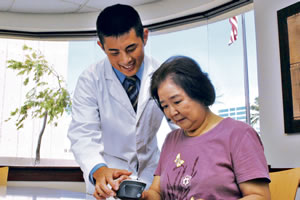
Aids For Diminished Vision
November 02, 2011
By Dr. Kellen Kashiwa


Dr. Kellen Kashiwa
Low vision specialist at Retina Institute of Hawaii
Where did you receive your schooling and training?
I attended Pacific University in Oregon, where I received a Bachelor of Science degree and then my doctorate in optometry. I completed an internship in low vision at the Washington School of the Blind. I also completed internships in low vision in Okinawa at the Naval Hospital and at Wenzhou Medical College in China. In China, I interned in a retinal practice with a low-vision department that would see about 100 patients each day.
Each spring break throughout optometry school, I did eye care humanitarian missions to Peru, Nicaragua and the Philippines. We’d travel to remote villages that had no eye care for miles, and have the privilege to serve about 500 patients each day with proper eye care. It’s such a wonderful feeling seeing the joy in someone’s eyes when they put on their first pair of glasses and they can finally see the world clearly.
{embed=“elements/box_ad”}
What is low vision?
Low vision is when vision can’t be corrected with glasses, contacts or surgery. Low vision aids and visual rehabilitation training can maximize people’s abilities to read and see, improving their quality of life.
How does someone acquire low vision?
Low vision can be a result of different diseases, such as macular degeneration, glaucoma, diabetes or eye trauma.

|
What are some of the methods you use to help people who have low vision?
Every exam starts by asking the patient what they want to do that they currently can’t because their vision has been decreased. From there, I cater each exam toward their visual goals. It’s different from a regular eye exam; it’s more of a specialty exam.
What are some examples of low-vision aids and visual-rehabilitation training?
Low-vision aids include magnifiers, telescopes, specialty designed spectacles and electronic devices that maximize their remaining vision. In visual rehabilitation here at the Retina Institute, we have an instrument that can help people use their eyes to improve reading speeds and their vision over training sessions. That’s one of the things we’re excited about because no one else in Hawaii offers it. It’s an instrument that uses biofeedback to train patients to utilize healthy parts of their retina to maximize their remaining vision. In specific diseases that affect central vision like macular degeneration, motivated patients can dramatically improve their reading speeds and visual acuity through training with this device.

|
How prevalent is low vision?
There are 3.6 million visually impaired Americans over 40, and that number is going to double over the next 30 years due to the baby boomers. Low vision awareness is key. We’re the only site in Hawaii that offers this degree of low vision rehabilitation. Some of the tools and techniques that we offer are brand new to Hawaii.
Does insurance cover low vision treatment?
Most insurances including Medicare cover the exam and training sessions.
However, just as Medicare does not cover glasses, low vision aids are not covered by most insurance companies.
{embed=“elements/google_ad336x280”}
Being that you work at the Retina Institute, how are retina and lowvision related?
They go hand-in-hand. It’s a perfect relationship because retinal diseases decrease vision drastically. I just saw a patient whose vision continues to decrease even though she was provided the best care. With some of these diseases, vision just keeps getting worse. That’s where I come in. I’m kind of the last line of defense to maximize their abilities. This patient hasn’t been able to read for 10 years and didn’t know the types of low vision therapies and aids out there. Today I got her to read with low vision training. It’s a really rewarding feeling.
How do you discern low vision from some other malady?
Low vision can be detected during a routine eye exam. If vision is impaired (poor visual acuity, glare, night vision, etc.) and can’t be improved with glasses or contacts, they should be evaluated for low vision. When people give up reading, watching TV and simple tasks due to their visual impairment, they should be evaluated because there’s so much out there that people don’t know about that can improve their quality of life and vision.